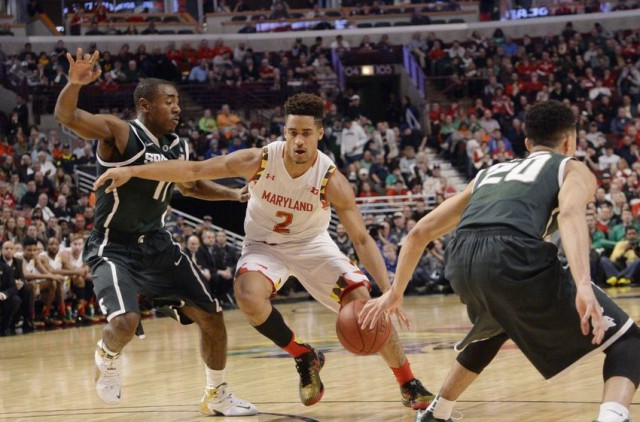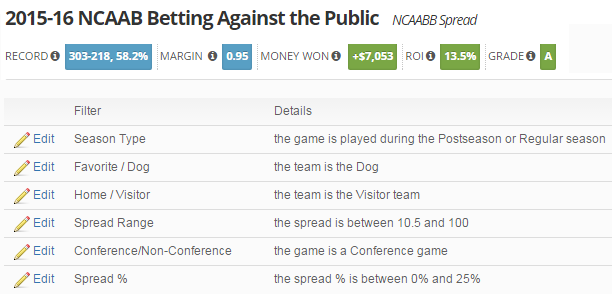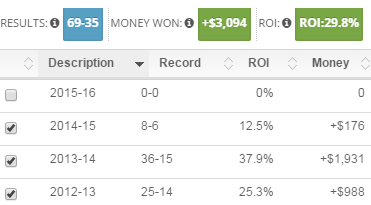
2015-16 College Basketball Betting Against the Public Report
Prior to the start of every season, we publish a series of betting against the public reports which detail the sweet spot for contrarian betting. By utilizing our public betting trends from seven contributing sportsbooks, we are able to see which teams the public is loading up on and then take the other side.
The basic strategy behind our betting against the public philosophy is quite simple. In the sports betting marketplace, there are two types of bettors: “sharps” and “squares.” Sharps are typically wise guys or betting syndicates who spread large bets across multiple sportsbooks. Widely respected, sharps are a smaller group who move lines across the sports betting marketplace.
Most casual bettors can be classified as squares. These are recreational weekend warriors who place their wagers based on instinct, rather than number-crunching and data analysis. Squares have a tendency to pound favorites and overs, which has historically created value on underdogs and unders. We have also found that basketball bettors tend to place too much weight on the importance of home court advantage, which has created additional value on road teams.
Imagine the sports betting marketplace as a seesaw. If too many square bettors load up on one side (typically caused by an overreaction to recent results), oddsmakers will need to even the weight by adjusting the line and encouraging action on their opponent. These shaded lines create additional value for contrarian bettors who are willing to go against the grain and take the unpopular side.
In some instances, the line will actually move against the public betting trends. For this example, let’s say that Team A is receiving just 20% of spread bets as an 8-point underdog. You would expect that oddsmakers would adjust their line to +8.5 or +9 to encourage more action on that side. However, if the line slips to +7.5 or +7, it is referred to as reverse line movement — i.e. when the betting line moves in the opposite direction of the public betting percentages.
This reverse line movement would indicate that even though more bettors are taking Team B, more total dollars have been wagered on Team A. Reverse line movement is a sure sign that smart money, or large wagers made by wise guys or betting syndicates, has come in on Team A.
There are rare instances when sharps and squares are on the same side, but typically these instances can be tracked by monitoring steam moves — i.e. sudden drastic and uniform line movement across the entire sports betting marketplace.
We mentioned earlier that visitors and underdogs have been undervalued historically, so we decided to start our analysis by focusing on that criteria. Since 2005, underdogs have gone 19,032-18,923 ATS (50.1%) while road ‘dogs have gone 12,303-11,861 ATS (50.9%). As we begin to apply our contrarian filters, we find that our returns are less than desirable.
| Public Betting | Record (ATS) | Winning Percentage | Units Won | ROI |
|---|---|---|---|---|
| All | 12,303-11,861 | 50.9% | -165.62 | -0.7% |
| ≤49% | 8,402-8,053 | 51.1% | -59.66 | -0.4% |
| ≤40% | 5,671-5,449 | 51.0% | -47.46 | -0.4% |
| ≤35% | 4,061-3,919 | 50.9% | -50.89 | -0.6% |
| ≤30% | 2,569-2,506 | 50.6% | -58.04 | -1.1% |
| ≤25 | 1,398-1,365 | 50.6% | -30.58 | -1.1% |
These results were extremely disappointing, but not completely unexpected. Our past research has revealed three important facts for college basketball bettors:
- The value of betting against the public is directly correlated with the number of bets. If more bets are being placed on a game, it’s more likely that oddsmakers will be forced to adjust their lines based on an influx of square money.
- Underdogs have performed exceptionally well in conference games, as the familiarity between the teams levels the playing field and disproportionately benefits the team getting points.
- Bettors love to take favorites, and they have a particular admiration for huge favorites. For that reason, double-digit underdogs have offered additional value for contrarian bettors.
In order to capitalize on these historical trends, we wanted to layer on additional filters to improve our results. We started by examining favorites of at least 10.5-points and our returns immediately improved.
| Public Betting | Record (ATS) | Winning Percentage | Units Won | ROI |
|---|---|---|---|---|
| All | 4,286-4,042 | 51.5% | +30.86 | 0.4% |
| ≤49% | 3,303-3,094 | 51.6% | +47.16 | 0.7% |
| ≤40% | 2,356-2,226 | 51.4% | +16.08 | 0.4% |
| ≤35% | 1,742-1,631 | 51.6% | +26.45 | 0.8% |
| ≤30% | 1,164-1,123 | 50.9% | -15.27 | -0.7% |
| ≤25 | 701-669 | 51.2% | -0.54 | 0.0% |
Essentially, this research confirmed that double-digit underdogs have offered tremendous value for college basketball bettors but it didn’t really improve our betting against the public strategies.
The main problem is that our system included many games that did not receive a large enough volume of bets for our contrarian strategies to work. If there’s not enough public money taken on the favorite, oddsmakers won’t be forced to artificially inflate the underdog line. To remedy this, we decided to focus on conference rivalries which typically take significantly more bets than non-conference games.
As you can see from the table below, the results were staggering.
| Public Betting | Record (ATS) | Winning Percentage | Units Won | ROI |
|---|---|---|---|---|
| All | 2,424-2,135 | 53.2% | +165.20 | 3.6% |
| ≤49% | 1,773-1,510 | 54.0% | +174.03 | 5.3% |
| ≤40% | 1,187-994 | 54.4% | +134.06 | 6.1% |
| ≤35% | 836-668 | 55.6% | +126.64 | 8.4% |
| ≤30% | 521-428 | 54.9% | +66.91 | 7.1% |
| ≤25 | 303-218 | 58.2% | +70.53 | 13.5% |
Other than the slight drop off at the 30% threshold, the winning percentage and return on investment steadily improve as we look as increasingly one-sided public betting. Our sweet spot comes when we examine double-digit road underdogs who are receiving no more than 25% of spread bets. Teams fitting these criteria have gone 303-218 ATS (58.2%) with +70.53 units won and a 13.5% return on investment.
This system has 521 past matches in 11 seasons, which averages roughly 47 plays per year. That number has been slightly lower over the past three seasons; however, in that time the system has performed remarkably well with a 69-35 ATS record (66.3%) and +30.94 units won
Bet Labs users are able to copy this system directly from our Think Tank, and bettors are able to view the latest odds and trends from our free college basketball odds page. Have any questions for the staff at Sports Insights? Utilize our live chat to speak with a customer service representative or e-mail us at help@sportsinsights.com.
4/7/16 Update: The featured system went 23-20 ATS (+1.79 units won) during the 2015-16 season. That pushes the all-time record to 362-238 ATS (57.8%) with +72.32 units won.



Joe Steve
11/11/2015 at 12:42 amwhy narrow down the system to +70.53 units won when you already found that >49% will get you 174 units over time? Aren’t we in this to make money after all?
David Solar
11/11/2015 at 8:33 amYes, but that would also require taking a large number of plays. You’ll notice that the return on investment continues to improve as we examine increasingly one-sided public betting which gives us more confidence in the system.
Benjamin Wang
11/13/2015 at 6:58 amI’m a bit confused. Shouldn’t all the Public Betting columns in the tables be =?
Brian Smith
11/13/2015 at 7:59 amAwesome breakdown. Thank you! Sadly no matches tonight though :( I like narrowing it down. Looking forward to applying this
Larry Gessler
11/23/2015 at 10:17 pmCan I assume that this strategy involves all conferences and not the “elite” ones?
David Solar
11/24/2015 at 7:53 amThat’s correct. The final system is shown in the screenshot near the bottom of the article. It needs to be a conference game, but it doesn’t necessarily need to involve teams from a power conference (i.e. ACC, Big Ten, SEC, etc…)
Jim Jones
11/25/2015 at 8:59 pmThe percentage is even higher in the NBA and the NFL. I shoot when it’s 25% or less on the points and its been hitting over 70% winners
Jay Schaap
01/05/2017 at 11:40 pmIn the NBA and NFL does it have to be a divisional game or any matchup.
Mike
12/02/2015 at 11:34 pmDoes the timing of when the pick is made make a big difference and is there a way to filter that or figure out what that difference is? Can I assume these are all closing lines? And if so how close to each game should a pick be analyzed/placed? As close to game time as possible?
For example, early line shows 75% on favorite but by game time this has moved to 60% on the underdog.
David Solar
12/03/2015 at 1:48 pmYes, our Bet Labs system matches are based on the closing lines at Pinnacle. For that reason, it’s important to wait until close to game time before placing your bet. This will ensure that the trends/lines are unlikely to move and thus fall out of the system.